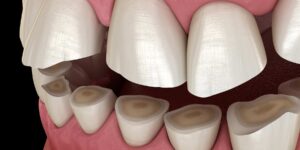
Did you know that almost 50% of the adult population suffers from gum disease? Looking at this staggering number, it is essential to understand the symptoms of gum disease to ensure early treatment and prevent complications, like tooth loss. February happens to be National Gum Disease Awareness Month, so let’s discuss the causes, symptoms, and what you can do to protect your teeth and prevent gum disease.
What causes gum disease?
Our mouth is a host to millions of bacteria, and while most of them are harmless and even essential, some can be disease-causing. Improper oral hygiene leads to the accumulation of bacteria-laden plaque on the surfaces of the teeth and near the gumline. With time, the plaque hardens and converts to tartar which can only be removed with professional dental cleanings. The bacteria from these causes inflammation and can lead to gingivitis and periodontitis (gum disease).
Gingivitis is the initial, mild form of gum disease and can be prevented and in some cases, can be reversed with prompt dental care and routine dental cleanings
What are the symptoms of Gum Disease?
Gingivitis symptoms include swollen, puffy, or bleeding gums. The gums may appear red, be tender to touch, and at times, it is possible to have pus discharge from the margin of the gums.
If gingivitis is left untreated, it progresses to its severe form: periodontitis. Periodontitis is a destructive disease of the gums; it breaks down the structural integrity of the gum tissue and leads to bone loss. The gums appear fiery red, swollen, and are painful.
Other symptoms can include a reduction in gum tissue, bone loss, which exposes the tooth’s root, and can lead to teeth sensitivity. Oftentimes, gums may bleed easily upon brushing, flossing, or when biting down on something like an apple.
Periodontitis can also cause the teeth to loosen and shift due to structural breakdown on the gum and surrounding bone. Tooth loss may occur without proper dental treatment.
Periodontitis is also associated with a foul metallic taste in the mouth and bad breath.
What can you do to prevent gum diseases?
The first thing is to maintain good oral hygiene. Brush your teeth twice a day using a soft nylon toothbrush and a high-quality fluoride toothpaste. It is also essential you change your toothbrush once every three months or earlier if the bristles become frayed.
Make a habit of flossing every day to ensure you get rid of any debris and plaque in between the teeth.
Rinse your mouth often, especially after your meal, to ensure no food debris remains in the mouth.
Nutritional deficiencies make the body more susceptible to infections. Therefore, it is vital to consume a balanced diet rich in nutrients, vitamins, and minerals.
Lastly, ensure you schedule regular dental check-ups and teeth cleaning to stay at the top of your oral health.




